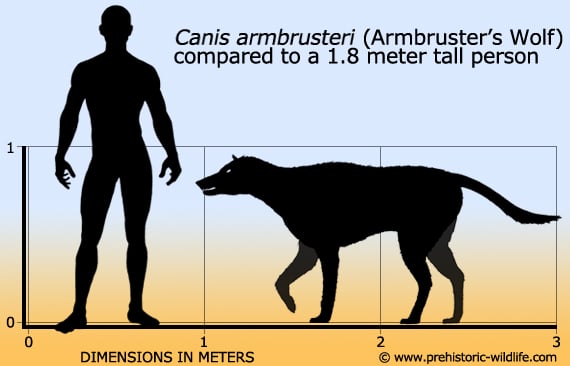


Canis armbrusteri
(Armbruster's Wolf)

Name: Canis
armbrusteri
(Armbruster's Wolf)
Phonetic: Can-is arm-bruss-teh-ri (Arm-bruss-terz
Wolf).
Named By: J. W. Gidley - 1913.
Classification: Chordata, Mammalia, Carnivora,
Canidae, Canis.
Species: C. armbrusteri.
Type: Carnivore
Size: Average 1.5 meters long.
Known locations: Throughout the USA.
Time period: Calabrian to Ionian of the Pleistocene.
Fossil representation: Numerous individuals are
known.
Armbruster's
Wolf is considered to be the direct ancestor to the more well-known
dire
wolf, as indicated by gradual changes in its bone structure
that
took on identifiable dire wolf features. Although it gave rise to the
dire wolf, Armbruster's wolf lost ground to its larger descendent being
steadily pushed towards the East coast, until the latest surviving
members being known from Florida during the latter half of the Ionian
stage.
The
overall morphology for Armbruster's wolf is quite similar to its
descendent the dire wolf, save for the skull which is narrower. This
may indicate that Armbruster's wolf had a smaller bite force.
Further reading
- Preliminary report on a recently discovered Pleistocene cave deposit
near Cumberland, Maryland. - J. W. Gidley - 1913.
- Phylogenetic systematics of the North American fossil Caninae
(Carnivora, Canidae) - Richard H. Tedford, Xiaoming Wang, Beryl E.
Taylor - 2009.
Random favourites
 |
 |
 |
 |




